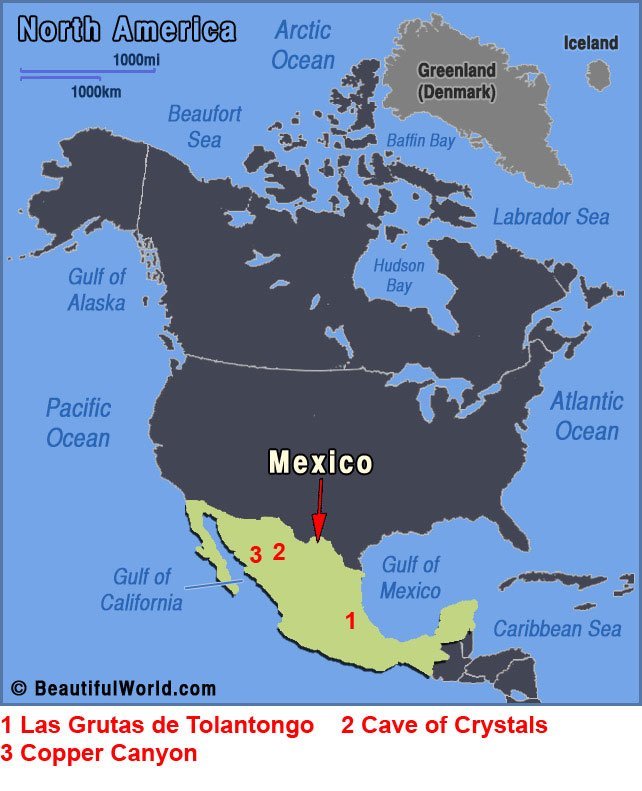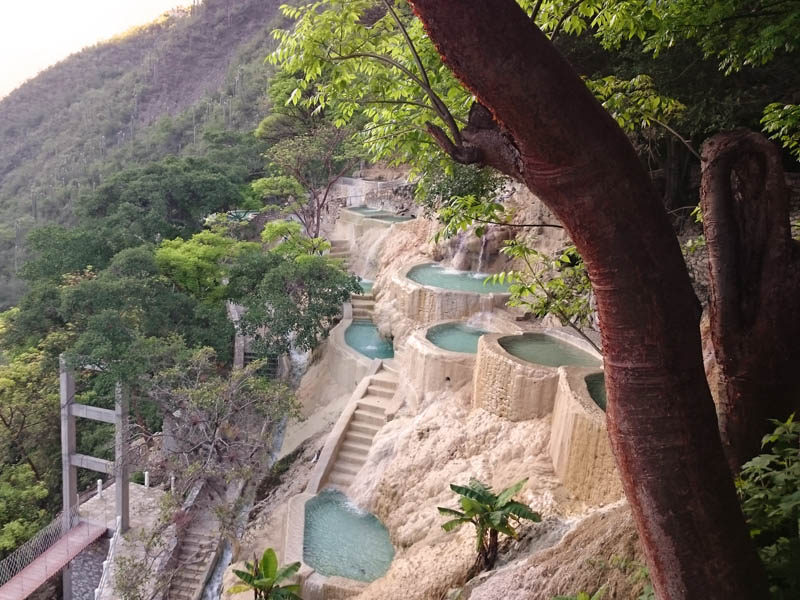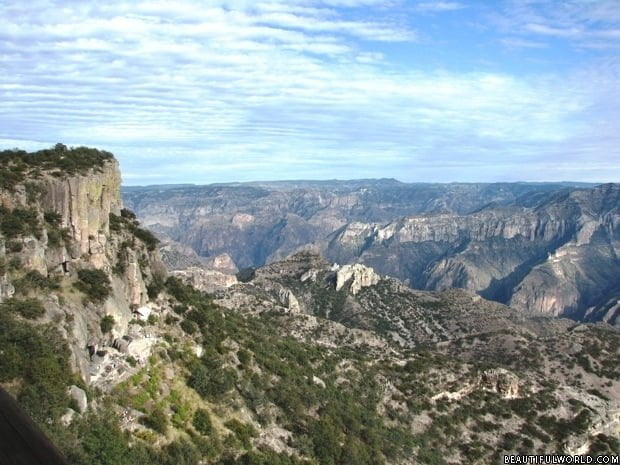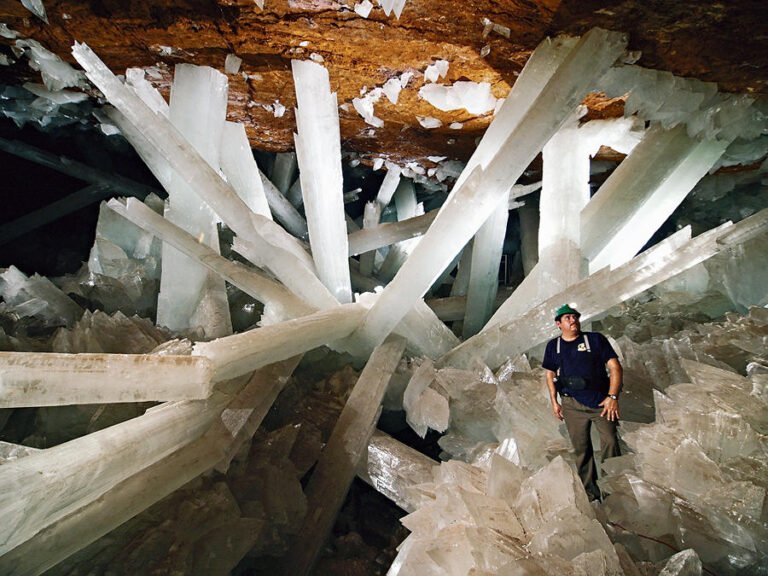Like many of the world’s most beautiful places, Tolantongo remained a well-kept secret enjoyed by local people for many years. It was not until the 1970s that this area was brought to the attention of the wider public and it has since gone on to achieve world-wide fame. Although there is no town or village bearing this name, Tolantongo is now widely used not only for the river but also for the resort complex and of course the Grutas de Tolantongo (Tolantongo Caves).

Tolantongo has the grid reference 20 degrees 40 minutes North, 98 degrees 56 minutes West and it is located deep in the Valle de Mezquital in the State of Hidalgo approximately 200 kilometres north-east of Mexico City. The origins of the name Tolantongo are rather uncertain but the most likely source is from the Nahuatl word Tonaltonko which has been translated as: “Home where it feels warm” or “Place where it flows warm”. It was certainly known as Tonaltongo locally long before it became famous and it appears that its present name came about simply as a result of a spelling mistake at the time that it was being promoted to the world in magazine articles in the 1970s. It is now universally known by its misspelt name Tolantongo.
How to get to Tolantongo
Most visitors to Tolantongo arrive by car and the availability of regular public transport is by no means guaranteed. There may be some problems if relying on GPS systems for navigation but it is easily accessed from Route 27. After leaving the main highway, the final leg of the trip may be a rather bumpy ride as the road leads downwards in a series of hairpin bends on a largely unfinished surface.
The Microclimate of Tolantongo
Descending deeper and deeper into the canyon, a noticeable change can be observed in the nature of the vegetation. This region of Mexico is generally semi-desert in nature but at Tolantongo, due to the presence of copious amounts of water and high levels of humidity, lush greenery is evident giving the place an oasis-like quality.

The Geology of Tolantongo
This rocky landscape comprises largely of weathered limestone with many cracks and fissures. This is usually referred to as a karst formation and a characteristic feature is that such rock formations are very porous allowing rainwater to penetrate to great depths. The slightly acidic nature of rainwater also reacts with the alkaline calcium rocks resulting in the formation of caves and underground streams. Some of the world’s most spectacular caves are karst caves.
The Warm River Tolantongo
The River Tolantongo is a result of underground water and, at the head of the canyon, it flows out into the valley below. The river is coloured due to the presence of mineral salts and is of a blue-green appearance often described as “turquoise” or “aqua” but its other amazing quality is that it is heated. Waters emitting from these rocks have been subjected to volcanic heating to a greater or lesser degree. The warm river waters are chilled to some extent by other joining cooler waters but remain at a suitable temperature for swimming. The river water passes down over a series of shallow cascades leaving many natural swimming pools.
Grutas (Grottos) de Tolantongo
At the head of the canyon can be found the grottos, known as the Grutas de Tolantongo. Here can be seen stalactites, stalagmites and other incredible natural sculptures. The first main grotto forms a sizeable hall, the roof being over 10 metres high beyond that is a further cavern referred to as the Tunnel due to its long thin shape. It is often regarded as being around 15 metres long but does extend further into the rock but with ever reducing dimensions making further exploration suitable only for experienced potholers (cavers). Some climbers do make the ascent to the higher parts of these caves but obviously this is only for the most experienced.
It must be said that, although Tolantongo is now a popular resort, the caves have been kept very much in their natural state. These are certainly not “Show Caves” with viewing platforms and exhibits and the full extent of their commercialisation is little more than a guide carrying a torch.

A major attraction of Las Grutas de Tolantongo is the presence of natural hot water. Entry into the Tunnel is said to be similar to taking a hot shower or entering a steam bath and just outside the grottos, the waters form natural spas in the form of rimmed pools. Water is everywhere and even cascades down the steep sides of the canyon. These natural hot pools (pozas termales) are not limited to the Cave area and three more known as La Gloria can be found clinging to the valley sides.
Where to Stay in Tolantongo
In addition to the area’s natural wonders, it is now also operated as a popular resort with three hotel complexes along with camping facilities for those preferring to get down to nature.

What to do in Tolantongo
Sporting activities include hiking, climbing, abseiling, caving, swimming and there is also a zip-line. Tolantongo is also famous for its many man-made hot pools, known as Chapoteaderos. These take the form of roughly semicircular structures built to catch the hot waters flowing from the valley walls. In these pools, visitors can relax and enjoy the view of the rich green valley often with mists and low clouds shrouding the higher rocks, a very different scene to the arid Mexican landscape just a few miles away.
Tolantongo and Local Ownership
Perhaps one of the most surprising things about Tolantongo and its many attractions is the fact that it owes its existence not to any major business interests, government schemes or sponsorships but entirely to the efforts and actions of the local people. The ownership of large areas of land in this region is with local people. 112 families share in the ownership of the San Cristobal ejido on which is located much of the resort complex. The other side of the valley, including the La Gloria pools forms part of the La Mesa ejido. Tolantonga is run both by and for the benefit of the local people with part of the revenue generated being constantly reinvested in the site. There can be few better examples of successful cooperative management and perhaps only the Mexican people could show such dedication and single-mindedness.
Tolantongo is open every day and any visitor to Hidalgo should put it on their “to visit” list. It has been described as a tropical paradise or Garden of Eden and most visitors cannot wait to return. Any visitor to Mexico can expect a warm welcome but at Tolantongo it is guaranteed to be both warm and wet!




Anyone driven to the caves from San Antonio? How long does it take and are there any good places to stop on the way?
we drove from san diego calif on our way to Mexico city it was a drive just make sure your vehicle in in great shape and you have great insurance for towing and repairs in case of issues , people are mostly nice
How would we get there and book accommodations
The hotels do not take reservations. Go there on a weekday and you should be able to book a room. If not, there are hotels in Ixmiquilpan. Take a bus from CDMX to Ixmiqilpan andthen a shuttle bus to Tolantongo. Google time s for the shuttle from Ixmiquilpan to Tolantongo. Hope this helps.